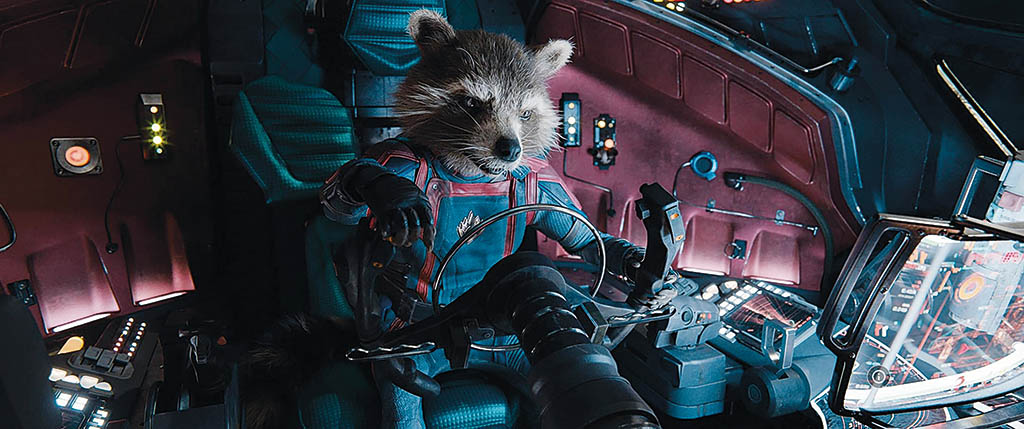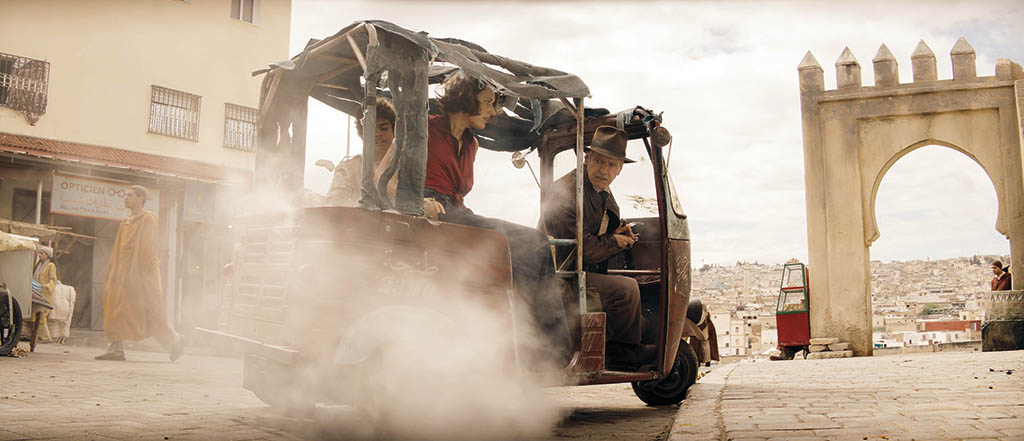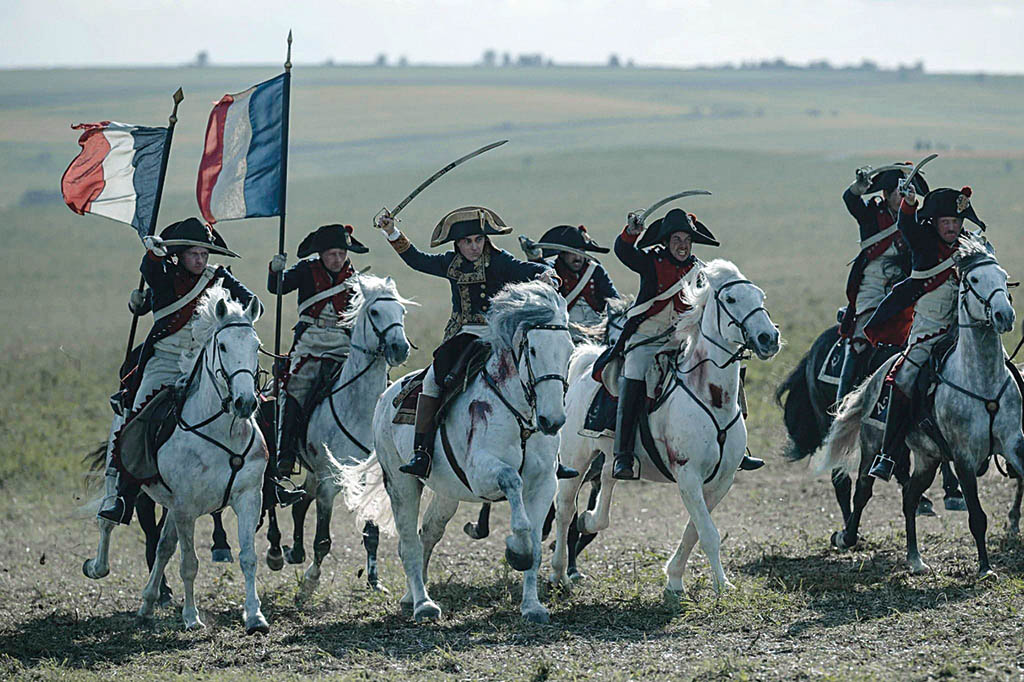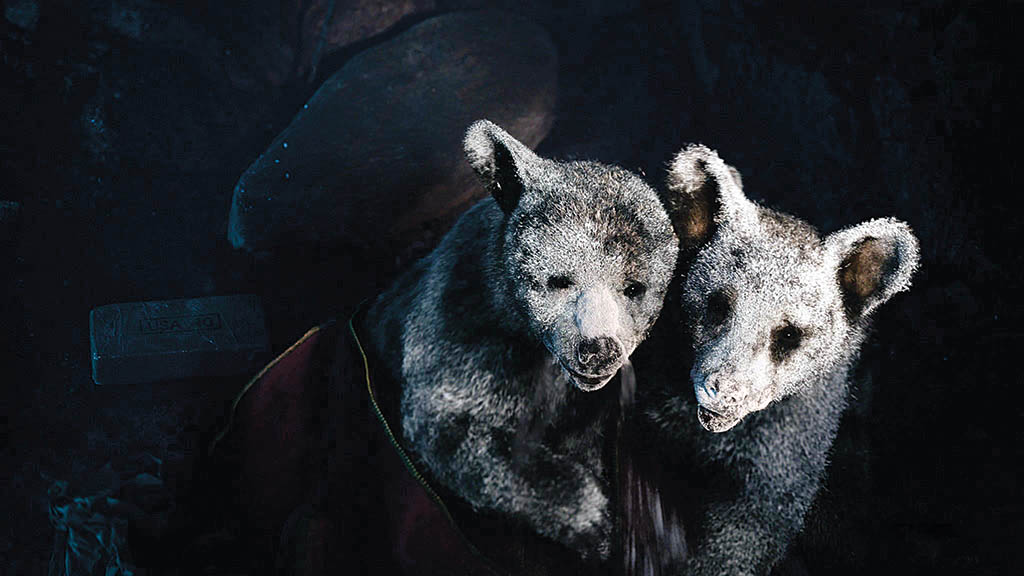By OLIVER WEBB
By OLIVER WEBB

Preferring to shoot practically, Christopher Nolan aimed to avoid CG effects when making Oppenheimer. SFX and filmed elements were used to capture the power of the Trinity nuclear test. (Image courtesy of DNEG and Universal Pictures)
Last year, Avatar: The Way of Water scooped the Academy Award for Best Visual Effects, beating Top Gun: Maverick, Black Panther: Wakanda Forever, All Quiet on the Western Front and The Batman. When the nominees are announced on Tuesday, January 23, for Best Visual Effects at the 96th Academy Awards, it will be another competitive year with outstanding films in contention for the VFX Oscar.
Nominated for Best Visual Effects in 2014, the first Guardians of the Galaxy installment narrowly missed out to Interstellar. In 2017, Guardians of the Galaxy Vol. 2 saw itself nominated for the award, this time losing out to Blade Runner 2049. A third-time’s-the-charm win would be fitting for the third and final installment; although it should be noted that with the extraordinary craftsmanship of the film’s Visual Effects Production Supervisor, Stephane Ceretti, and all of the VFX vendors involved, it would be anything but luck, as Vol. 3 remains a serious forefront contender. “We had 3,066 visual effects shots in the film, a huge number,” says Ceretti, who also worked on the first film. “On top of that, we had to do the Christmas special at the same time, which was an additional 560 shots.”
Ceretti credits Guardians series director James Gunn for constantly evolving and challenging his VFX team to break new ground. “James Gunn always wants things to look as real as possible,” Ceretti explains. “He’s got his filming style that’s very specific to him, and that has evolved from the first Guardians film. He was really challenging us in terms of how he is now filming things with smaller cameras that are really portable and moving all the time. We knew that we had potentially a lot of full CG sequences, especially with the flashbacks. We had discussions about the different worlds that we would either revisit from previous films, like Knowhere, or the new places that we would introduce like Counter Earth or The Orgoscope. We worked alongside Production Designer Beth Mickle, who is fantastic and had previously done The Suicide Squad with James.”
Rocket proved to be the most challenging CG character to create for Ceretti and his team. “It was great to come back and finish the story of Rocket,” Ceretti says. “We knew we had to build Rocket across his different ages throughout the film. There was also a sense of an animalistic feeling that we had to get from Rocket that, in my opinion, we had lost a little bit across the different films.” Ceretti adds, “The emphasis on the high level of detail in terms of both modeling, grooming and keyframe animation for all of these animals was really key for the success of the movie and being able to tell that story.”
Indiana Jones and the Dial of Destiny marked the titular character’s return to the big screen. With Andrew Whitehurst serving as Visual Effects Supervisor, the film consisted of 2,350 visual effects shots. Whitehurst describes, “Because the movie is a journey, most scenes take place in different times and locations. It’s a story that has many components with little overlap between them. We knew that the scope of the work would mean that we would need several vendors on the show. By the time we were starting to think about that, Kathy Siegel, the VFX Producer, was onboard, so we were talking about the various folks that we might approach to work on it and who’d we worked with before, and who we knew specialized in certain types of work. It was an exercise in logistics really.”

Driven by more than 3,000 visual effects shots with many fully CG sequences, Guardians of the Galaxy Vol. 3 remains a serious standalone contender, even though the first two films were nominated but missed out in 2014 and 2017. (Image courtesy of Marvel Studios)
Along with the prologue, the Siege of Syracuse sequence was one of the main focus points in the pre-production of Dial of Destiny. “We started blocking it out with Previs Supervisor Clint Reagan,” Whitehurst notes. “[Editor] Mike McCusker, who was cutting that sequence, was on the project by then. We were exploring the sequence through previs and storyboards because a screenplay often isn’t the best place to explore an action sequence like that. The other thing we needed to figure out was how to film it and how the narrative would drive the layout of the environment. In my office in L.A., I had a map on my whiteboard that I was forever updating with what ancient Syracuse looked like based on the cut. I had all the various story beats as thumbnail sketches drawn on Post-it notes that I was laying out along the planes’ trajectories as I drew them out on the board. From that we could work out how the coastline and the city had to be laid out to accommodate that action. Previs was also vital in working out how we might stage action in the plane set pieces that we had at Pinewood. We were able to figure out ahead of shooting how we could get our actors, crew and cameras into such a confined space. It saved a lot of time on the shoot.”
“Everyone working on the film was very conscious of the previous films and the way that they were made,” Whitehurst explains. “The thing you will hear more from Jim [director James Mangold] when you are on set or talking about previs shots, is ‘nouns and verbs.’ Every shot needs a noun and every shot needs a verb. That’s a very classical filmmaking way of working, and I think that attention to detail really shines through in the finished film.”

With a tip of the visor to Blade Runner and the Lucasfilm legacy, Gareth Edwards’ The Creator introduces a brave new sci-fi world, both compelling and grounded in real-world locations that ring true. (Image courtesy of 20th Century Studios)

With 2,350 visual effects shots, including a prologue and a portal-through-time visitation to the Siege of Syracuse in 200 BC, Indiana Jones and the Dial of Destiny shines with a keen attention to a treasure chest of detail. (Image courtesy of Lucasfilm Ltd)

Gritty and grounded, Transformers: Rise of the Beast stars robots that reflect the different environments they inhabit, and features complex character animation and FX simulations in almost every shot. (Image courtesy of Paramount Pictures)


Ridley Scott’s Napoleon conjures a broad historical canvas of 18th century France with battlefields and thousands of soldiers, requiring a seamless weave of practical, CG and invisible effects that all contribute to the film’s unique look. (Image courtesy of Apple Studios and Columbia Pictures/Sony)
Following Rogue One: A Star Wars Story, Gareth Edwards was at the directing helm again with The Creator. FIN VFX contributed over 100 shots for the film. “By the time we joined the project, The Creator had been in Gareth’s head for years,” says FIN VFX Supervisor Stuart White. “When we received our first shots to begin work on, ILM had already finalized a large number of their shots, having had about a two-year head start. So, the expectations were high! I’ve long been a fan of concept artist [Production Designer] James Clyne. He and his team at ILM had been working on the most amazing body of concept art for this movie that I think I’ve ever seen, all handed to us as a PDF that numbered hundreds of pages.” Discussing the most challenging visual effects shot to create, White notes a shot where two (CG) police transport ships land in an alleyway, and about nine (partially CG) robots jump out of it and run into a building. “In the postvis, they had replaced the whole top half of the frame with a still that basically implied ‘insert Blade Runner awesome future city alleyway and skyscrapers here.’”
Joe DiValerio of Outpost VFX served as VFX Supervisor and interacted with Charley Henley, Production Visual Effects Supervisor, for Ridley Scott’s Napoleon. “Our work was just under 30 shots, which we ultimately hope are invisible. The film has a unique look and style we needed to adapt to,” DiValerio says. “We had a sequence, fleshed out shot design, and a solid plan of shot plates and elements that needed to be assembled. There was some amazing roto and paint work to preserve the essence of the practical element photography. We had some very clever uses of mixing up the photography in ways it wasn’t originally intended – mixing up takes, augmenting stunt work, mixing angles and standard hiding logistics of the practical effects. The biggest challenge we anticipated was the CG crowd work. The production team had motion capture performances with specific actions for our sequence. We were able to build a library of just the right parts and then art-direct them into the film. Our sequence had a little bit of everything, matte painting, CG FX, crowds, element work and stunt enhancement.”

The Little Mermaid surfaces from the deep blue for live-action on land, but not without blending in merfolk and classic Disney animated undersea characters: Scuttle, Sebastian and Flounder. Characters built by Framestore. (Image courtesy of Walt Disney Studios).
Rodeo FX completed 237 VFX shots for The Little Mermaid with Graeme Marshall and Ashley Bellm both serving as Rodeo FX Visual Effects Producers on the film. “We were only one of multiple vendors,” say Marshall and Bellm with one voice. “As on most projects, we interacted mainly with the client-side VFX team, helmed by VFX Supervisor Tim Burke, and VFX Producer Leslie Lerman. Their team was an absolute delight to work with. Although we did receive notes from Rob [director Rob Marshall], our main point of contact was the studio VFX team. Rodeo was initially brought on board to take on some overflow character work from another studio. All of the merfolk shots were pretty challenging, there was a lot of plate reconstruction and integration to be done. Our most difficult shot was in the closing scene of the film when Ariel’s family and community join her on the beach to send her off on her adventures with Prince Eric. The shots with Scuttle, Sebastian and Flounder were also challenging as the character assets – built by our friends at Framestore – were shared across multiple vendors, and we had to ensure continuity not only in their appearance, but in their overall demeanor and performance.”


Rodeo FX recreated Place de L’Étoile in Paris, one of the busiest locations in the world, for John Wick: Chapter 4. The John Wick franchise is known for its stylish, choreographed action sequences and gunfights.(Photo: Murray Close. Courtesy of Lionsgate)

Wētā FX designed, built and animated Cokie and her two cubs for Cocaine Bear. (Image courtesy of Universal Pictures)

ILM’s VFX team worked closely with Production Designer James Clyne and the art department to develop the rich design framework of The Creator. (Images courtesy of 20th Century Studios)

Indiana Jones and the Dial of Destiny. (Image courtesy of Lucasfilm Ltd)
One of the most highly anticipated films of the year was Christopher Nolan’s Oppenheimer. The combined effects departments created over 200 shots and only half of those needed post work in VFX. Production VFX Supervisor Andrew Jackson was the first person to read the Oppenheimer script after Producer Emma Thomas. “Chris told me before I read the script that he wanted to avoid computer-generated effects,” Jackson says. “He thought if we could shoot it practically, it would fit better with the language and feel of the film. His approach to effects is very similar to mine in that we don’t see a clear divide between VFX and SFX, and believe that if something can be based on filmed elements it will always bring more richness and depth to the work. After my initial discussions with Chris, I spent the first three months of the project in SFX Supervisor Scott Fisher’s workshop, developing and testing dozens of simulations and effects. For the duration of the shoot, we ran a small VFX IMAX film unit, which compiled an extensive library of filmed elements. The final shots ranged from using the raw elements as shot, through to complex composites of multiple filmed elements led by VFX Supervisor Giacomo Mineo and the team at DNEG, the film’s sole VFX partner.


Barbie will likely be in contention for Best Production Design, but the film’s visual effects should not be overlooked. (Images courtesy of Warner Bros.)

Guardians of the Galaxy Vol. 3. (Images courtesy of Marvel Studios)
“Each shot presented its own set of challenges as the script describes thoughts and ideas rather than specific visual images,” Jackson continues. “This was both exciting and challenging as we searched for solutions we could build and shoot that were both driven by the story and visually engaging. Combined with the set of creative rules like only using real elements shot on film, this meant that we had to dig deeper to find solutions that were often more interesting than if there had been no limits. The one sequence that was the most challenging was the Trinity test itself. Unlike the other effects scenes, this one needed to replicate the original test but still be made only using filmed elements. It was a huge design and compositing exercise, involving retiming and combining multiple high-speed explosion and ground detail elements. The result is a truly unique cinematic experience.”

Real locations and a preference for practical effects ground Blue Beetle in a family-friendly everyday sense of reality that offers superhero VFX on a down-to-earth scale. (Image courtesy of Warner Bros.)

Oppenheimer. (Image courtesy of DNEG and Universal Pictures)
MPC and Wētā FX were the lead studios on Transformers: Rise of the Beasts, and the number of visual effects shots ended up in the 1,800-1,830 range. “[Director] Steven Caple Jr. and I met in pre-production when there was only a script. He’d been gathering mood material and came in with a good idea of the world he wanted. It was a more grounded, gritty and distressed look he was after,” says MPC VFX Supervisor Gary Brozenich. “We discussed a heavier patina for the robots in general and wanted to link the look of their aging to the places they inhabited. The Autobots are city dwellers and the Maximals are jungle-dwelling – we should feel the environment in their shell. Both should have a different quality. Unicron and its interior carried the weight of introducing the franchise’s ultimate villain, one that is ingrained in the lore and the minds of a huge fan base. We wanted to make sure we were true to the original structural design in its planetary form.”
Matt Aitken was Wētā FX Visual Effects Supervisor on the film. “Our work on the show was all complex with character animation and FX simulations in almost every shot. The transformation shots were particularly challenging; we set up a dedicated transformation team comprising specialists from animation, rigging and models to handle the specifics of those, and some of the transformation shots were in progress throughout our time working on the movie. The most difficult transformation sequence was probably Mirage transforming into an exosuit around Noah as he slowly stands up. We kept Noah’s face but most of the time his body, clothing and hair has been replaced to allow the articulating suit pieces to neatly form around him. That was the last shot we delivered on the show!” Wētā FX also provided the bulk of effects for Cocaine Bear. “Our work on Cocaine Bear focused on the furry, drug-fueled lead, Cokie, a CG black bear that goes on a rampage after stumbling on abandoned cocaine in the wilderness,” notes VFX Supervisor Robin Hollander.
This year, audiences also saw Brie Larson reprise her role as Captain Marvel in The Marvels, which undoubtedly will be a contender at the Academy Awards, while DC’s Blue Beetle could be an outside pick. This year also marked the return of John Wick with John Wick: Chapter 4, an excellent addition to the franchise. Barbie will certainly be in contention for Best Production Design. The film’s visual effects are also worth special mention. Whichever film wins the award for Best Visual Effects, it has been an incredible year for film VFX.